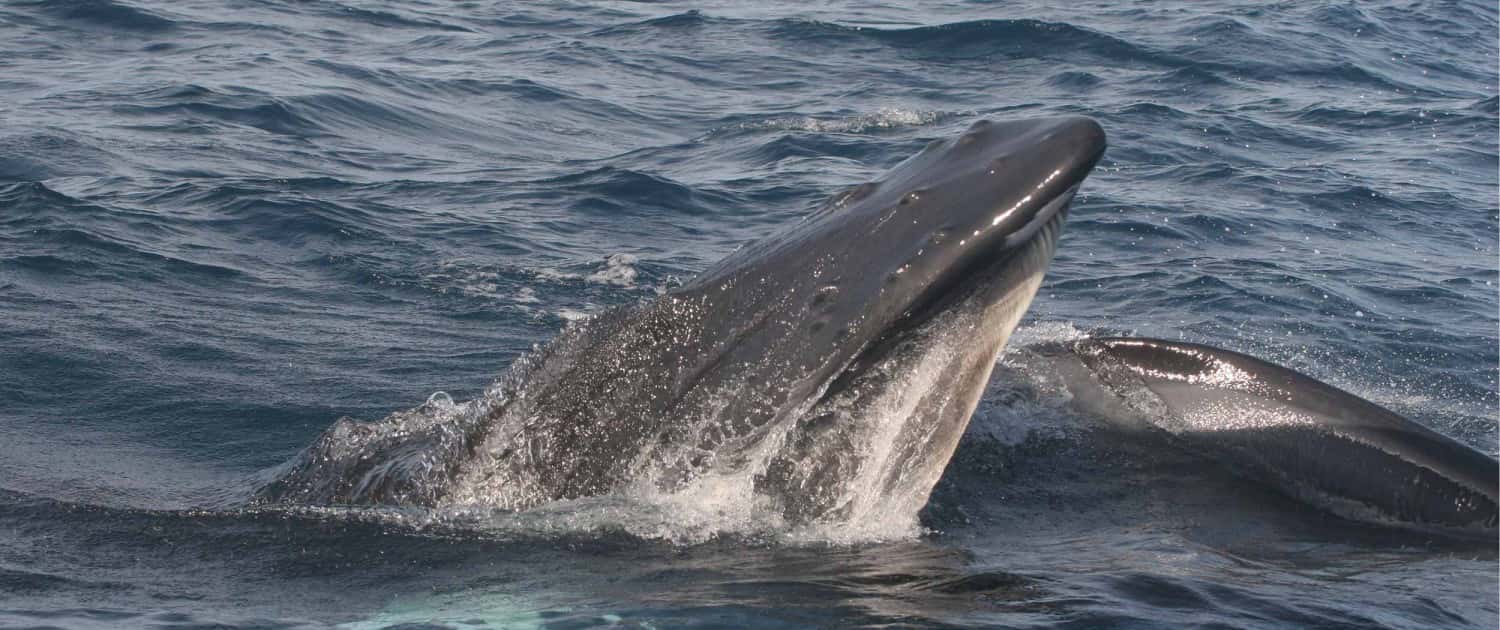Caribbean
Tethys’ researchers participated in two cruises organised by the Woods Hole Oceanographic Institution to study sperm whales (Watkins et al. 1993) Physeter macrocephalus and other odontocetes (Watkins et al. 1994) in the waters off the island of Dominica.
A series of research cruises to describe distribution and relative abundance of several cetacean species, including Bryde’s whales Balaenoptera edeni, common minke whales B. acutorostrata, and long-beaked common dolphins Delphinus capensis, was organised from December 1993 to March 1994 in the coastal waters of Venezuela, the Lesser Antilles and Puerto Rico aboard Tethys’ former research vessel Gemini Lab. Methods included visual sighting surveys and acoustic monitoring with a towed hydrophone array.
Western Sahara
During winter 1996 a field expedition to the coastal waters of Southern Morocco/Western Sahara was organised with finding from the Whale and Dolphin Conservation Society, with the participation of the Groupe d’Etudes des Cétacés et Pinnipèdes du Maroc, Rabat, and of the New England Aquarium, Boston. Goals included: 1) to verify if North Atlantic right whales (Eubalaena glacialis) could still be found in that area, known from ancient whaling logbooks as a former wintering ground for this endangered species; 2) to evaluate environmental conditions of the region and assess its suitability as a potential future right whale breeding habitat; 3) to investigate the status of other cetaceans living in the area; and 4) to help establishing a cetacean sighting and stranding network in co-operation with local authorities. The survey yielded no cetacean sightings except inside Dakhla Bay, were small groups of common bottlenose dolphins (Tursiops truncatus) and Atlantic humpback dolphins (Sousa teuszii) were found to co-exist. Local knowledge of a regular, predictable presence of large whales in the coastal zone was lacking. On such grounds the hypothesis that the area still serves as a winter concentration site for the remnants of an eastern North Atlantic right whale population, although not falsified by this study, seems rather unlikely (Notarbartolo et al. 1998).
Canary Islands
Research cruises in the Canary Islands were conducted from aboard Tethys’ former research vessel, Gemini Lab, during a three-year winter-study in the waters off, respectively, Lanzarote (1995), Tenerife (1996) and Gomera (1997), to strengthen the scant information existing at that time (mostly based on stranding reports) on cetacean distribution in the Canaries. Pelagic cetaceans included spotted dolphins Stenella frontalis, and short-beaked common dolphins Delphinus delphis; these two species seem to alternate seasonally within the area. Occasionally, beaked whales were also encountered along the continental slope. Successive observations targeted the ecology of particular species, such as short-finned pilot whales Globicephala macrorhynchus, the regular presence of which was confirmed off Tenerife and within the less touristic waters off Gomera. A comparison of the pilot whale behavioural responses to the presence of vessels between groups occurring in the two study sites – the highly trafficked waters off Tenerife and the calmer conditions off Gomera – was indicative of a significant impact from whale watching on the whales off Tenerife (Politi et al. 1997) .
Red Sea
Between 2004 and 2014 members of Tethys engaged in research and conservation activities in Egypt, focusing on the ecology and conservation status of cetaceans found along Egypt’s Red Sea coast, between Hurghada and the border with Sudan. In 2004 experts from Tethys were asked by the Egyptian government to develop a management plan (Notarbartolo 2004) of Samadai, an open sea coral lagoon containing a resting area for spinner dolphins (Stenella longirostris). Work included investigating the dolphin presence in the lagoon and monitoring (Notarbartolo et al. 2009) the effects of management, as well as training the rangers in the collection of monitoring data. Subsequently, a cooperative work was started with HEPCA, a local NGO, within the framework of a wider project envisaging, inter alia, density surveys of several species of dolphins found in the area, with support from the Italian – Egyptian Debt Swap Programme. This work generated the first ever quantitative survey of cetaceans in the Red Sea, yielding population estimates for spinner (S. longirostris), pantropical spotted (S. attenuata), Indo-Pacific bottlenose (Tursiops aduncus), common bottlenose (T. truncatus), and Risso’s dolphins (Grampus griseus). (Costa 2014)
Literature
Watkins W.A., Daher M.A., Fristrup K.M., Howald T.J., Notarbartolo di Sciara G. 1993. Sperm whales tagged with transponders and tracked underwater by sonar. Marine Mammal Science 9(1):55-67.
Watkins W.A., Daher M.A., Fristrup K., Notarbartolo di Sciara G. 1994. Fishing and acoustic behavior of Fraser’s dolphin (Lagenodelphis hosei) near Dominica, Southeast Caribbean. Caribbean Journal of Science 30(1-2):76-82.
Notarbartolo di Sciara G., Politi E., Bayed A., Beaubrun P.C., Knowlton A. 1998. A winter cetacean survey off Southern Morocco, with a special emphasis on suitable habitats for wintering right whales. Reports of the International Whaling Commission 48:547-550.
Politi E., Notarbartolo di Sciara G., Mazzanti C. 1997. Cetaceans found in the waters surrounding Lanzarote, Canary Islands. European Research on Cetaceans 10:107-112.
Notarbartolo di Sciara G. 2004. Samadai Dolphin Sanctuary 2004 provisional management plan. Interim Report to EEAA – Nature Conservation Sector. 7 p.
Notarbartolo di Sciara G., Hanafy M.H., Fouda M.M., Afifi A., Costa M. 2009. Spinner dolphin (Stenella longirostris) resting habitat in Samadai Reef (Egypt, Red Sea) protected through tourism management. Journal of the Marine Biological Association of the United Kingdom 89(1):211-216. doi:10.1017/S0025315408002221
Costa M. 2014. Abundance and distribution of delphinids in the Red Sea (Egypt). Thesis submitted in partial fulfilment for the degree of PhD at the University of St. Andrews. 294 p.


